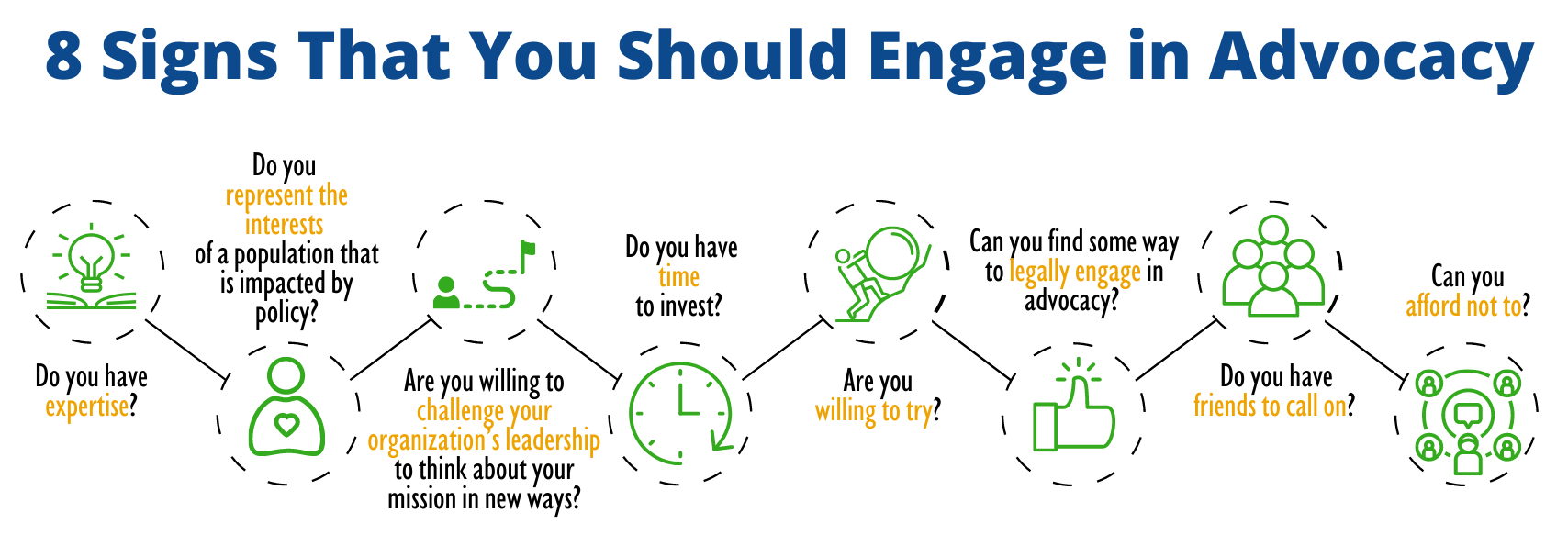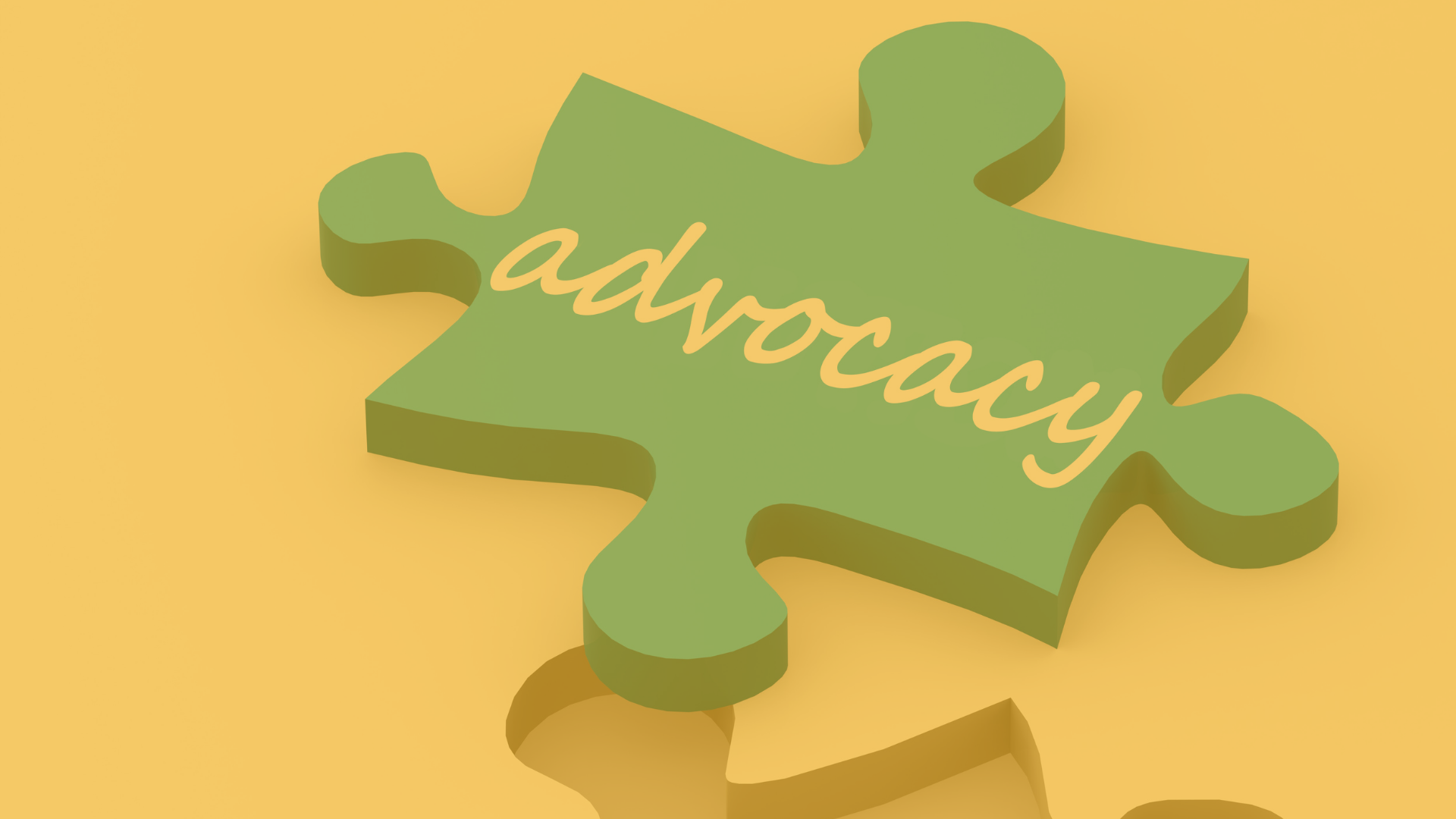8 Signs That You Should Engage in Advocacy… Right Now
A blog we wrote five years ago on criteria for determining if organizations are ready for effective advocacy has been trending lately, and I cannot help but worry about those organizations that might read that article and determine they don’t clear the bar. While nonprofits should certainly assess their efforts, I want to pair that word of caution with a call to action. Engaging – or not engaging – in advocacy can mean the difference between good policy and bad policy, something which can have generational consequences for you, your organization, and the community you serve.
The point of the post that has been trending lately, titled Seven Success Factors for Adopting an Advocacy Strategy, was to provide a framework for determining potential effectiveness in undertaking advocacy work as a nonprofit. At the time that post was written there was a new surge of individuals advocating and a slew of organizations wondering where they might be able to make an impact. The post identified seven elements needed to maximize efficacy. Five years later, as someone new to La Piana Consulting, but seasoned in advocacy, I urge you to use those factors to shape how you think about advocacy, but not deter you from getting engaged.
My longest stint in the nonprofit sector was as CEO of a statewide organization focused on using policy change to improve conditions for Texas children. From that seat, what I saw was not a glut of nonprofit advocates that needed winnowing, but a dearth. Without fail, on controversial issues, the voices of experts in working with people through human services or the arts were vastly outnumbered by corporate lobbyists. On many other issues, those with no profit considerations, but with potential for great impact on many lives, there was often hardly anyone walking the halls of the Capitol. While I had a fair number of advocate counterparts also working for positive social changes, we were generally either outspent and outnumbered or desperately trying to garner attention for an issue or population that no one was talking about.
So, for those of you pulling up our old post, considering dipping a toe in the advocacy waters, and perhaps promptly deciding you don’t have what it takes to be successful in this arena, I say grab those goggles and dive in. You can use our original post as a lens if you want to evaluate your current advocacy infrastructure, but know that those seven steps we outlined are not the bar for considering engagement. Your voice is needed, so let’s shift from talking about the seven factors that will determine success to the eight signs that your voice needs to be heard.

- Do you have expertise? So often expertise is described by resumé points like work experience or degrees earned. However, the expertise that is most needed in policy forums of all kinds is experience living with the consequences of policies under consideration. While our initial post recommended using the lens of a “proven track record” the perspectives of fresh new organizations just coming to grips with social issues can bring significant insights. While a proven track record and storied history of service delivery is a boon, don’t let the newness of your social sector work serve as a limitation on engaging in advocacy. The survivors of the 2018 Stoneman Douglas High School shooting didn’t have a long history of advocacy to propel them forward. They took the expertise they had as a community grieving for their collective losses and organized, mobilized, and got noisy. They not only garnered mass attention, they attracted partners, and began to push for and achieve significant policy changes. Not only do you have your own experiences in the community to pull from, as a nonprofit leader, you are actively engaged in improving your community. This is invaluable expertise.
- Do you represent the interests of a population that is impacted by policy? Our original post correctly noted that many well-established advocacy organizations mobilize a highly developed grassroots base and activate donors to influence policy. While a solid base is a wonderful structure to utilize, that does not need to be the starting place for engagement. Consider whether you, your staff, board members, volunteers, or individuals you serve might be able to engage in reaching out to policymakers. On the state level, I often heard from legislative offices that they knew a topic was hot when they received six constituent calls on the issue. Six! Surely, your organization has six contacts you can rally to support a cause. While some issues garner more attention than others, how many times are policies with wide impact passed with barely a flutter of activity around them? More often than you would imagine. We all live with the consequences of good and bad policy, so if you are working with a cause of any kind, you are representing interests of someone who will be impacted by policy decisions. It’s time to get those impacted parties heard.
- Are you willing to challenge your organization’s leadership to think about your mission in new ways? Sure you are. As a nonprofit professional you are probably (hopefully!) doing it all the time. While our original post noted the value of having board leadership committed to advocacy, we advise that you consider that any area of organizational growth requires testing new things. Leadership approval and acceptance are a great place to start for trying out new advocacy efforts. The commitment likely will not come until leadership sees these efforts in action. Consider starting small in terms of resource expenditure and see if you can find your leadership champions who join in your enthusiasm for this work.
- Do you have time to invest? While our original post noted the value of having a budget line item for advocacy, as you dip toes into the waters of advocacy, consider whether there is existing or volunteer time that can be dedicated to the effort. You don’t need to go from not engaging at all to maxing out your 501 (h) election or setting up a 501 (c) (4) overnight. While we know most professionals in the nonprofit sector are stretched thin and wearing many hats, it’s a question of upstream and downstream investment in time. Working to influence policy can ease the acuteness of need that your mission seeks to serve.
- Are you willing to try? It’s pretty much impossible to be in the nonprofit sector today and not hear the call for a well-articulated theory of change for your efforts, something our original post called for. And certainly, there are some methods of engagement that are more effective than others. But that said, we shouldn’t be so committed to proof that we undercut our willingness to innovate, to deviate from our organizations’ historical approaches to addressing issues. Advocacy is not a strategy that either works or doesn’t. It is the process by which policy change happens. Period. It’s the vehicle. You are either trying to influence those policies in your environment or you aren’t. If you aren’t, then you are just dealing with the consequences of policy decisions you weren’t engaged in. Either choice is yours to make (and either choice is legitimate), but remember, others are pushing and pulling policy. The only question is whether you are engaging too.
- Can you find some way to legally engage in advocacy? (Spoiler: Most probably!) This is a good time to chat with that lawyer you just recruited to the board, but haven’t figured out how to engage yet. Let them know there are great resources out there (One such great resource is Bolder Advocacy. They have some great resources and trainings and can provide guidance based on your local laws.), and get your board member’s blessing. There are many, many ways to engage in policy that don’t touch the realm of lobbying or other activity that you would have to track and report, let alone be restricted from doing. Our original post emphasized the advantages of an organizational structure conducive to advocacy, but if you are just getting your feet wet, it might not be necessary to determine whether your structure is conducive to it. Let’s lower the bar again here – Is there some way that you can engage in this work within the confines of your current structure? (Again, see resources above, but most likely the answer is a resounding yes!) Then give it a go, and see where it takes you. It may be that you need more structure for a sustained effort, but likely there are small steps you can take now.
- Do you have friends to call on? The advice from our original post in this realm rings true today. If you can join with allies, all the better. As in all other areas, collaboration makes the work less lonely and has the potential to amplify your message. All the better if you can bring unlikely allies together. Within the field I worked in, some of the coalitions that were particularly effective were those that brought together unusual partners – like law enforcement and people with lived experience accessing mental health services. We were honored to partner with highly effective advocates who were navigating systems directly under policy consideration – youth in foster care, individuals accessing publicly-funded health services, etc. Some partners will be more aligned than others and certain individuals might have greater readiness for action than others, but again, let’s not make perfect the enemy of good. Simply said, get engaged and bring friends if you can. If you can’t, that’s okay too.
- Can you afford not to? Decisions that will directly impact your ability to carry out your mission are being made all the time. Those conversations will take place whether or not you engage in them, and your organization will have to live in the environment those policies create. The question then becomes not whether you should be advocating and whether you have the key elements for success, but rather whether you can afford not to advocate. Policymakers often make judgements about whether a constituency cares about an issue or at least whether they will be an obstacle to making a change based on whether the group is vocal on an issue – regardless of whether that correlation is at all valid.
So, if you are looking at the Seven Success Factors seeking to create a robust advocacy effort – go for it. If you are already actively engaged and seeking next level influence, we applaud you. But please, if you haven’t gotten involved yet, know that you don’t have to have everything worked out in order to engage, and your voice is most certainly needed.
Policy is a long-haul game. You get noticed, then you get heard, then you make change. Like so many things, it can come down to relationship-building. It doesn’t happen overnight, and gains made are always at risk of being lost due to political amnesia or someone else’s voice being louder than yours. It requires a reframe on how you judge success, and most importantly a willingness to get in the game.
Have you started your advocacy journey? What worked, and what didn’t? Wondering where to start with advocacy? Look for an upcoming blog from us on the numerous ways to advocate.


Comment section